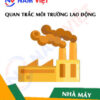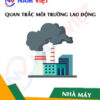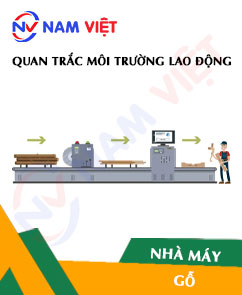Occupational Environment Monitoring at the Bank Card Swiping Machine Manufacturing Plant
99,000 ₫
Note: The above price is calculated for one sample, and the price may vary depending on the area of the environment to be monitored and market fluctuations. For more accurate pricing support, please refer to the quotation table or contact our consulting staff directly.
Occupational environment monitoring at a bank card swipe machine manufacturing plant is a process of collecting, analyzing, and evaluating workplace factors that may harm workers’ health.
Table of Contents
Toggle1. Overview of Bank Card Swiping Machine Manufacturing Factory
a. What is a bank card swiping machine manufacturing factory?
A manufacturing factory of bank card swiping machines is a production facility specialized in manufacturing various card swiping devices used in the banking and financial sector. Bank card swiping machines are typically used to read information from bank cards and perform financial transactions such as cash withdrawals, bill payments, money transfers, balance checks, and many other functions related to bank cards.
Bank card swiping machine manufacturing factories must comply with quality and safety regulations to ensure that the produced machines meet industry standards and requirements.

b. Production stages in a bank card swiping machine manufacturing factory
The production stages in a bank card swiping machine manufacturing factory may include:
- Assembly of basic components: Basic components such as the display, keypad, card reader, and other electronic parts are assembled into the main device.
- Installing components and electronic circuits: Components such as the motherboard, chips, memory, and other circuits are installed into the card swiping machine to ensure accurate and reliable operation.
- Quality and performance testing: Assembled machines undergo quality and performance tests to ensure they function according to specifications and meet banking industry requirements.
- Software installation: The machines are installed with control software and relevant applications to ensure functionality and integration with banking systems.
- Product packaging: After testing and software installation, the machines are carefully packaged for protection and transportation to the usage location.
- Inspection and warranty: Some factories perform final inspections and provide warranties for the machines before delivery.

c. Types of machinery used in a bank card swiping machine manufacturing factory
In a bank card swiping machine manufacturing factory, various types of machinery and equipment are used during production. Some common machines include:
- Metal cutting and processing machines: Used to cut and process metal parts such as the casing, frame, buttons, and other components.
- Plastic molding machines: Used to mold and shape plastic parts of the card swiping machine, including the casing, keypad, and front/back panels.
- Printing and laser engraving machines: Used to print or engrave information, images, and logos onto machine components.
- Automated assembly and quality control machines: Used to assemble components and perform automated quality checks to ensure correct operation according to specifications.
- Software installation and testing machines: Used to install control software and related applications, then perform operational tests on the machine.
- Packaging machines: Used to package the card swiping machines into boxes or protective materials for transport.
- Inspection and warranty machines: Used for final inspection and to issue warranties before delivery.

d. Occupational diseases that workers in a bank card swiping machine manufacturing factory may face
Workers in a bank card swiping machine manufacturing factory may encounter several occupational diseases related to the work environment. Some common occupational diseases include:
- Respiratory diseases: Workers may be exposed to dust and chemical fumes from processing and using plastic materials, which can lead to pneumonia, bronchitis, and other respiratory issues.
- Skin diseases: Contact with chemicals during production can cause skin irritation, dermatitis, eczema, and other skin problems.
- Noise-related disorders: Some machinery generates high noise levels, and prolonged exposure may cause hearing loss or other auditory issues.
- Musculoskeletal disorders: Working in an industrial environment can place stress on joints and muscles, potentially causing back pain, arthritis, or musculoskeletal injuries.
- Chemical-related illnesses: Using chemicals in production and maintenance of card swiping machines can pose health risks if safety regulations are not followed.
To ensure safety and protect workers’ health, personal protective equipment such as protective clothing, masks, goggles, and safe work procedures must be applied. Compliance with labor safety regulations, periodic health checks, and safety education is also essential.

e. Popular types of bank card swiping machines on the market
There are many popular types of bank card swiping machines on the market, including:
- Single-function card swiping machines: Basic machines used solely for swiping and verifying bank card payments.
- Multi-function card swiping machines: Machines with multiple functions, including card swiping, receipt printing, transaction display, and advanced features such as touch screens and internet connectivity.
- Mobile card swiping machines: Compact, portable machines suitable for mobile businesses, restaurants, cafés, or temporary events.
- Contactless card swiping machines: Allow users to make payments by moving the card over the machine without physical contact.
- Automated card swiping machines (ATM): Machines located in banks or public spaces that provide card swiping, payment verification, cash withdrawal, balance checks, and money transfers.
- Convenience store card swiping machines: Machines installed in stores, supermarkets, or restaurants for fast and convenient customer self-payment.
2. Overview of Occupational Environment Monitoring Services
a. What is occupational environment monitoring at a bank card swiping machine manufacturing factory?
Occupational environment monitoring (or workplace environment measurement) at a bank card swiping machine manufacturing factory involves collecting, evaluating, and analyzing workplace environmental indicators. The goal is to take timely measures to minimize environmental impacts on workers’ health and prevent occupational diseases. Monitoring the occupational environment is a mandatory requirement for such factories.
Occupational environment monitoring plays a critical role in safeguarding and promoting workers’ health, as workers are the primary resource directly generating profit for the business. Prolonged exposure to hazardous or excessive occupational risks can negatively impact health and cause occupational diseases.
REGISTER FOR OCCUPATIONAL ENVIRONMENT MONITORING SERVICE
b. Nam Viet’s occupational environment monitoring program
Nam Viet’s occupational environment monitoring program is developed by monitoring engineers specializing in labor safety and environmental protection. Aiming to ensure workers’ health and safety, the program uses modern measurement methods to monitor air quality, water quality, microclimate factors, physical elements, dust, and more in the workplace. This program is vital for ensuring a safe working environment and protecting workers’ health.
Additionally, Nam Viet’s program plays an important role in researching and developing new solutions to improve workplace environmental quality. With the dedication and professionalism of monitoring experts, Nam Viet’s exclusive monitoring program represents a breakthrough in labor safety and environmental management in Vietnam.

c. Standardization in occupational environment measurement procedures
Standardization in Nam Viet’s occupational environment measurement procedures is crucial for ensuring the accuracy and reliability of measurement results. The program adheres to standards and standardized procedures recognized by the Ho Chi Minh City Department of Health, ensuring collected data is highly reliable for evaluating workplace conditions and making decisions to improve the working environment and protect worker health.
These standardized procedures also guarantee that measurements are conducted by highly qualified monitoring specialists with years of experience, allowing managers and experts to trust the results from An Toan Nam Viet and make accurate, valuable decisions to protect workers’ health and the environment.
By applying standardized procedures in workplace environment measurement, Nam Viet demonstrates its commitment to a safe working environment and the protection of worker health, while also contributing to the development and enhancement of labor safety and environmental management in Vietnam.
d. Reporting results of occupational environment monitoring at a bank card swiping machine manufacturing factory
Occupational environment monitoring results are prepared according to Form No. 04, Appendix III, issued with Decree 44/2016/ND-CP and prepared in two copies: one sent to the contracted workplace and one retained by the monitoring organization.
The retention period of occupational environment monitoring records is indefinite according to legal regulations.

e. Frequency of occupational environment monitoring as per legal regulations
According to Clause 2, Article 18 of the Law on Occupational Safety and Health 84/2015/QH13, employers must conduct occupational environment monitoring to assess harmful factors at least once a year.
f. Deadline for submitting occupational environment monitoring reports as per legal regulations
The deadline for submission is before December 31 each year. Enterprises under production facilities are required to submit occupational environment monitoring reports to the local Department of Health at the location of the main office and workplaces.
Whenever there are changes in technology, production processes, or renovations/upgrades that may introduce new hazards to workers’ health, enterprises must update occupational hygiene records regarding harmful factors that need monitoring.
g. Penalties for violations of occupational environment monitoring regulations for employers
According to Article 27 of Decree No. 12/2022/ND-CP dated 17/01/2022 on administrative penalties in labor, social insurance, and Vietnamese employees working abroad under contract:
- Clause 2: A fine of 2,000,000 – 5,000,000 VND for employers who fail to publicly inform employees at the monitored workplace and places of inspection/evaluation about hazardous factors immediately after monitoring results are available.
- Clause 3: A fine of 20,000,000 – 40,000,000 VND for employers who do not conduct occupational environment monitoring to control harm to workers’ health as required by law.
- Clause 4: A fine of 40,000,000 – 60,000,000 VND for employers who collude with monitoring organizations to commit fraud in occupational environment monitoring activities but not to the extent of criminal liability.
3. Harmful Environmental Factors for Workers in Bank Card Swipe Machine Manufacturing Plants
Harmful environmental factors in bank card swipe machine manufacturing plants may include:
- Noise: Machinery in bank card swipe machine factories often generates high noise levels during operation. Continuous and excessive noise can cause stress, fatigue, and affect workers’ health and psychological well-being.
- Dust and fine particles: The production and machining process of bank card swipe machines may generate dust and fine particles from the materials and processes used. Inhaling these particles can irritate the respiratory tract and cause health issues such as pneumonia and allergies.
- Chemicals: Certain chemicals may be used during the production of bank card swipe machines, such as solvents, adhesives, and cleaning agents. Exposure to these chemicals can cause skin, eye, and respiratory irritation, leading to conditions like dermatitis, rhinitis, and more serious health problems if not carefully managed.
- Glare: Strong lighting may be used during production to work with sensitive components. Glare can cause eye strain, discomfort, and impair workers’ vision.
- Temperature and humidity: The working environment in bank card swipe machine factories may have unstable temperature and humidity. High temperatures or humidity can cause discomfort and fatigue, affecting work performance and health.
REGISTER FOR OCCUPATIONAL ENVIRONMENT MONITORING SERVICE
4. Measures to Improve the Working Environment in Bank Card Swipe Machine Manufacturing Plants
To improve the working environment in bank card swipe machine factories, the following measures can be applied:
- Noise management: Implement technical solutions such as soundproofing, installing noise barriers, and using noise-reducing equipment to limit factory noise. Provide hearing protection devices for workers to protect against noise exposure.
- Dust and fine particle management: Ensure effective ventilation and dust extraction during production. Use dust collectors, air filters, and respiratory protection to prevent particles and dust from contaminating the work environment.
- Chemical management: Use safer chemical alternatives, limit the use of hazardous chemicals, and ensure proper storage, handling, and disposal according to safety regulations. Provide personal protective equipment such as gloves, safety goggles, and protective clothing.
- Glare management: Use light shields, anti-glare screens, or provide anti-glare safety glasses to reduce the impact of bright lights on workers’ eyes.
- Temperature and humidity management: Ensure air conditioning systems operate efficiently to regulate temperature and humidity in the workspace. Provide cooling, heating, or fans to create a comfortable working environment.
- Training and education: Provide training on occupational safety, environmental management, and the use of personal protective equipment. Increase awareness of potential hazards and occupational disease prevention.
- Compliance with occupational safety regulations: Follow local and national safety regulations, including routine inspection, maintenance, and calibration of machinery to ensure safety and operational efficiency.
- Regular evaluation and monitoring: Conduct periodic assessments of the working environment to identify environmental issues and propose improvements. Perform ongoing monitoring to ensure compliance with safety measures and environmental improvements.
- Periodically conduct occupational environment monitoring in factories, collect and analyze harmful factors affecting workers, and adjust to reduce risks to prevent occupational diseases.
5. Benefits of Periodic Monitoring in Bank Card Swipe Machine Manufacturing Plants
An Toan Nam Viet provides enterprises with excellent benefits when using occupational environment monitoring services according to Decree 44/2016/ND-CP on managing and controlling harmful factors in the working environment affecting employees.
- Enterprises can proactively control harmful factors in workshops or factories.
- Receive advice and recommendations on measures to minimize harmful factors and improve the quality of the working environment.
- Indirectly protect human resources, the key factor in business development.
- Reduce the impact of occupational diseases on health, lowering future treatment costs.
- Improve workers’ health, ensuring product quality and maintaining production output.
- Comply with occupational safety laws, avoiding legal risks.
- Enhance credibility and professionalism in all aspects, elevating the enterprise’s brand.
Nam Viet’s environmental monitoring service is a solution to minimize occupational disease risks, contributing to a clean and high-quality working environment.

6. Nationwide Occupational Environment Monitoring Center
The Occupational Environment Monitoring Center of Nam Viet is a professional unit specializing in supervising and measuring occupational environment quality across all provinces in Vietnam. With a team of experienced monitoring specialists, the center uses modern measurement equipment to ensure accuracy and reliability.
In addition to providing monitoring services, the center assists clients in planning, handling, and tracking occupational environment issues. With the motto “customers at the center,” the center prioritizes client satisfaction, meets all client needs, and commits to providing the best solutions for businesses.
REGISTER FOR OCCUPATIONAL ENVIRONMENT MONITORING SERVICE
With investments in technology, equipment, and personnel, Nam Viet’s monitoring center has become a reputable unit in occupational environment monitoring in Ho Chi Minh City, with the following objectives:
- We always value brand reputation and service quality.
- We provide clients with the best and most suitable solutions possible.
- Alongside a team of experienced Masters and Engineers committed to environmental protection and business benefit.
- By working with Nam Viet Environmental Monitoring, your company will receive professional service from field experts and enjoy the best cost advantages.
The occupational environment monitoring process at Nam Viet includes the following basic steps:
- Before monitoring, we ensure that all equipment is calibrated according to legal regulations.
- Strictly follow the occupational environment monitoring procedures committed to the Department of Health.
- Report monitoring results honestly to the employer.
- If results indicate unsafe conditions for workers, Nam Viet provides solutions, and the workplace will:
- Implement measures to improve working conditions to minimize harmful effects and prevent occupational diseases.
- Organize health examinations to detect occupational and work-related diseases early for employees in unsafe positions.
- Provide material compensation for workers according to labor law regulations.

7. Occupational Environment Monitoring Pricing
To help enterprises conduct professional and effective occupational environment monitoring, Nam Viet provides customers with a detailed and reasonably priced service quotation.
- Our pricing table provides detailed information on the costs of monitoring services, including travel, measurement, analysis, and reporting fees. Clients can rely on the accuracy and reliability of our monitoring reports.
- We commit to offering the most competitive and reasonable prices on the market and are always ready to provide fast and professional consultation on monitoring services.
- With Nam Viet’s quotation table, clients can easily select service packages that suit their needs. We guarantee maximum satisfaction with our professional service quality.
No comments yet












Review Occupational Environment Monitoring at the Bank Card Swiping Machine Manufacturing Plant
There are no reviews yet.